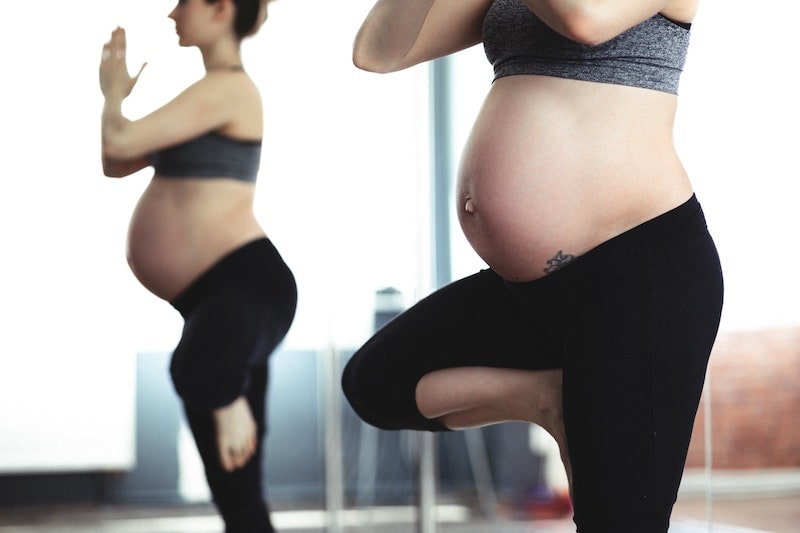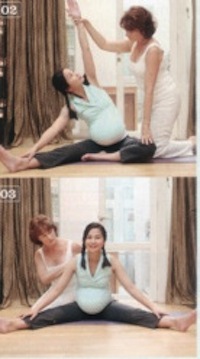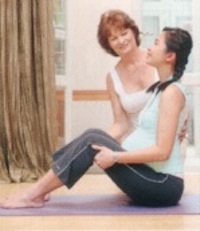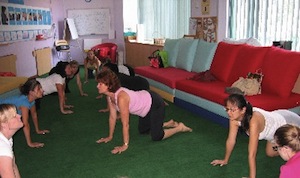
Colleen Simmonds is British and South African, and she has been living in Singapore for years. There, she teaches Yoga, particularly Prenatal Yoga. We have interviewed her here, and today she comes back to Expatclic with a very interesting article she has written on optimal foetal positioning and how Prenatal Yoga can help it. An article that will surely be of interest to future moms, and not only!
OPTIMAL FOETAL POSITIONING AND ITS INFLUENCE ON HOW WE SHOULD TEACH PRENATAL YOGA AND CHILDBIRTH EDUCATION
By Colleen Simmonds
“In the area of pregnancy and childbirth, every so often an idea emerges that has the potential to make a significant impact on the way women labour and give birth.” Sharron Cole, Childbirth Educator & National President of Parents Centre, New Zealand.
They say that during our grandmothers’ time, the length of the average labour was four hours but today it is more likely to be around fourteen hours! What has changed and what steps can we take to shorten labour? Most women will cope without pain relief if the labour is short, but a long, drawn out painful labour without pain relief is a tall order for anyone. Medical practitioners know that if a baby presents itself in the occipito-posterior position (OP), labour is inclined to be long and painful. So what is OP and what can we, as prenatal yoga teachers and childbirth educators do, if anything, to prevent babies from settling and presenting at birth in this position?
Optimal Foetal Positioning
Optimal Foetal Positioning is the term coined by Jean Sutton of Birth Concepts to describe the best possible position for a baby to be lying prior to the commencement of labour. This would mean the baby is in the occipito-anterior (OA) position or simply put, lying with head down, chin flexed with its back positioned away from mother’s back. The foetal head diameter at this point is 9.5cm and a fully dilated cervix is 10 cm, so relatively easy for baby to pass through the cervix and into the birth canal, via the pelvic brim.
Undesirable Foetal Positioning
 Undesirable Foetal Positioning (my term) is the above stated OP position which is when the baby’s back is against Mum’s back and the crown of the head presents at the cervix. The diameter of the head is on average 11.5cm at this point, which is too large to pass through the 10cm diameter of Mum’s cervix, and enter the pelvic brim, so labour doesn’t progress and the chance of medical intervention is greatly increased. Labour becomes slow and protracted while baby either rotates into the OA position or baby reduces its head size by moulding. This is where the membranous tissue, skin and soft bones are pushed forwards, slowly reducing the diameter of the head until baby can squeeze through the pelvic brim. Once in the pelvic cavity, he has to continue moulding to pass the Ischia spines before exiting the pelvic outlet. If he can’t pass the ’spines’ a C-section will most likely be carried out. The moulding of the foetal head will result in a caput forming over the presenting part. The baby is born with an elongated forehead which will take about 48 hours to assume a more normal shape.
Undesirable Foetal Positioning (my term) is the above stated OP position which is when the baby’s back is against Mum’s back and the crown of the head presents at the cervix. The diameter of the head is on average 11.5cm at this point, which is too large to pass through the 10cm diameter of Mum’s cervix, and enter the pelvic brim, so labour doesn’t progress and the chance of medical intervention is greatly increased. Labour becomes slow and protracted while baby either rotates into the OA position or baby reduces its head size by moulding. This is where the membranous tissue, skin and soft bones are pushed forwards, slowly reducing the diameter of the head until baby can squeeze through the pelvic brim. Once in the pelvic cavity, he has to continue moulding to pass the Ischia spines before exiting the pelvic outlet. If he can’t pass the ’spines’ a C-section will most likely be carried out. The moulding of the foetal head will result in a caput forming over the presenting part. The baby is born with an elongated forehead which will take about 48 hours to assume a more normal shape.
Is there anything pregnant women can do to help achieve OFP?
Yes – apparently the reason why so many babies nowadays present in the OP is due to our modern-day lifestyle. Most of us, especially in modern cities like Singapore, lead pretty sedentary lifestyles. Most chairs at work, car, plane or bus are comfortable bucket seats, which help create a slouched position when seated. So we spend most of our days sitting in this position, either while going to work, during work or watching TV. As a result, the pregnant woman creates a wonderful hammock for her baby at the back of the pelvis and baby settles comfortably there for the duration of the pregnancy. Since the baby’s back is heavier than the baby’s front, the baby settles with its back against Mum’s i.e. in the OP position. If the base of the pelvis is kept open or upright, the back of the pelvis forms a wall. Squatting or any posture that brings knees higher than her bottom creates a pelvic floor. Baby will push against the pelvic floor and move into OFP.
Exercise – tight abdominal muscles, especially relevant in a first time Mum, will often encourage the baby towards an OP position, so exercise and learning to relax these muscles is very helpful.
 HELPFUL POSITIONS AND ACTIVITIES
HELPFUL POSITIONS AND ACTIVITIES
- Maternal Postures and Exercises – from about 32 weeks onwards for first time Mums (primigravida) and 34 weeks onwards for the multigravida, she should use an upright and forward leaning posture wherever possible. This tilts the fundus (top) of the uterus forward and aims the baby’s head towards the cervix. Baby’s back is heavier than baby’s front, so gravity will assist in turning the baby into the desirable OA position. Watch TV sitting on a dining room chair or kneeling on the floor, leaning over a beanbag or a couple of floor cushions. If she has to sit on the sofa, she should place a firm cushion behind her bottom and lower back so she is sitting more upright. When resting or sleeping, she should lie on the left side with a cushion under her right knee, making sure her right floor is level with the leg to prevent foot cramps.
- Pregnancy Ball – sitting on the ball as often as possible, rocking back and forth and side to side is very helpful and should be used as much as possible, watching TV, computer time, meal times, etc.
- Swimming – great exercise but caution should be given that a screw kick in breaststroke could lead to misalignment of the hip bones in the lower back. Crawl kick while holding on to a flotation device is highly recommended.
- Prenatal Yoga – of course (!) Prenatal Yoga exercises help tone and stretch a woman’s body in preparation for birth. However, deep squatting should be avoided during the critical weeks in case a baby in the OP position is locked into this position during a squat.
- Alternative Medicine – acupuncture, acupressure and homeopathics can be used in conjunction with the woman adopting upright and forward leaning postures.
POSITIONS TO BE AVOIDED WHEN NEARING FULL TERM (32 weeks for first time Mum and 34 weeks for multigrads)
- Relaxing in semi-reclining position for long periods of time.
- Long trips in cars with bucket type seats.
- Sitting for long periods with legs crossed (this reduced the amount of space in the anterior part of the pelvis.
- Squatting – as an exercise, deep squatting is not advisable in late pregnancy unless the woman’s baby has ‘engaged’ in the pelvis in the OA position. An OP positioned baby can ’engage’ before it has had a chance to rotate to OA. Once the head is in the pelvis, rotation is a lot more difficult. However, in the last six weeks of pregnancy, a woman can do modified squats safely, using a stool (approx.25cm high) with a cushion on it. The stool should be placed against a wall so that the woman does not lean forward but rather keeps her spine vertical, supported along its length by the wall. The knees should be spread comfortable wide apart following the angle of her feet. Knees should be higher than her sit bones.
- Lying on her back in Reclined Cobbler Pose (Supta Baddha Konasana) even in a semi-reclined position during the last weeks can cause problems.
Tips to help Mum turn the baby just before and during labour:
- Walk up and down stairs.
- Rocking side to side.
- March on the spot or place a small stool in front of her, allowing her to lift one foot or the other on to it.
- Flexing and bending her pelvis during contractions.
- If on the bed, try side lying (left side to start) with a pillow or two under her uterus in order to lift it to the midline.
Who should teach Optimal Foetal Position?
ALL those involved in educating and caring for pregnant women, their partners and support persons. These include childbirth educators, physiotherapists, obstetrical nurses, midwives and doctors.
Who will benefit?
BABIES – quicker, more comfortable delivery and little stress to their heads. Quicker recovery and better post-natal progress.
MOTHERS – quicker, less painful labour usually negates the need for medical intervention and mother enjoys the transition to motherhood and all its complexities with a head start.
FATHERS – many Dads these day take on the duty of birth support or doula, seeing Mum in less pain and achieving the empowerment of natural birth and quick postnatal recovery is priceless.
OB/GYN & MIDWIVES – quicker less complicated labours result in less work and stress.
Conclusion:
The ability and the birthright of a woman to give birth naturally are being eroded. Most young girls in my classes come to me for the first time, unaware that a natural, non-medicated birth is possible. It is fast becoming a myth is this modern world. Seldom, if ever, do they have any idea that babies have optimal and undesirable positions for birth.
‘Babies who commence their journey in the optimal position make the birth process an exciting adventure, rather than a harrowing experience for all involved’. I would personally like to express my appreciation to Jean Sutton and Pauline Scott for their wonderful book “Understanding and Teaching OPTIMAL FOETAL POSITIONING” from which I gained my Oprah ‘Ah Ha’ moment and realized that THIS is something I can teach, finally I know my path.
Colleen Simmonds
C.H.Ed (Dip Yoga)
(Complimentary Health Education diploma in Yoga Teaching)
Sun-Gaia Yoga Certificate in Prenatal Yoga





